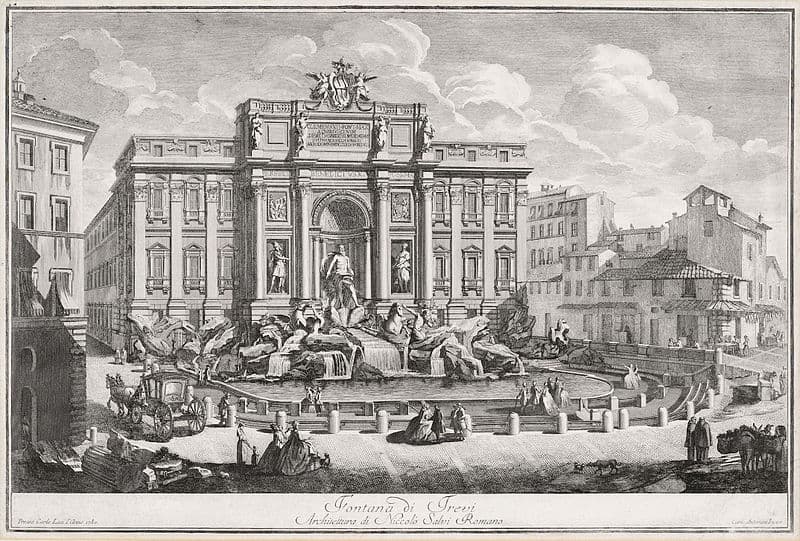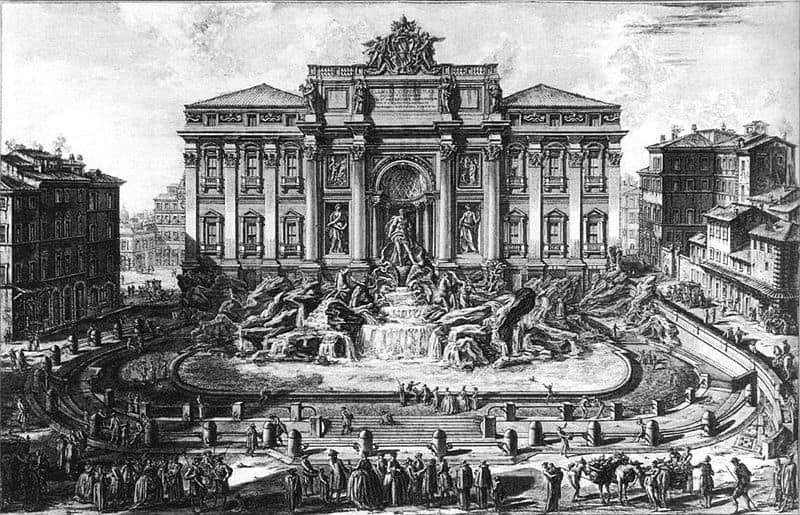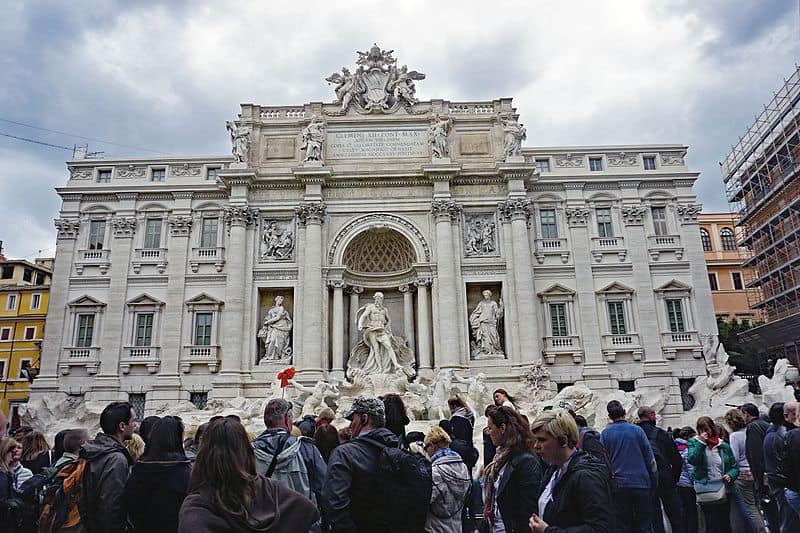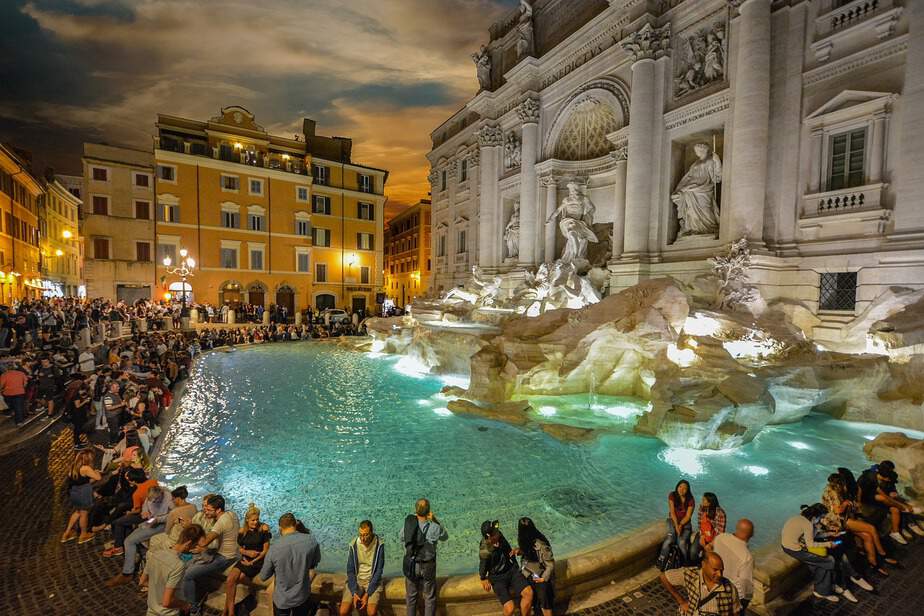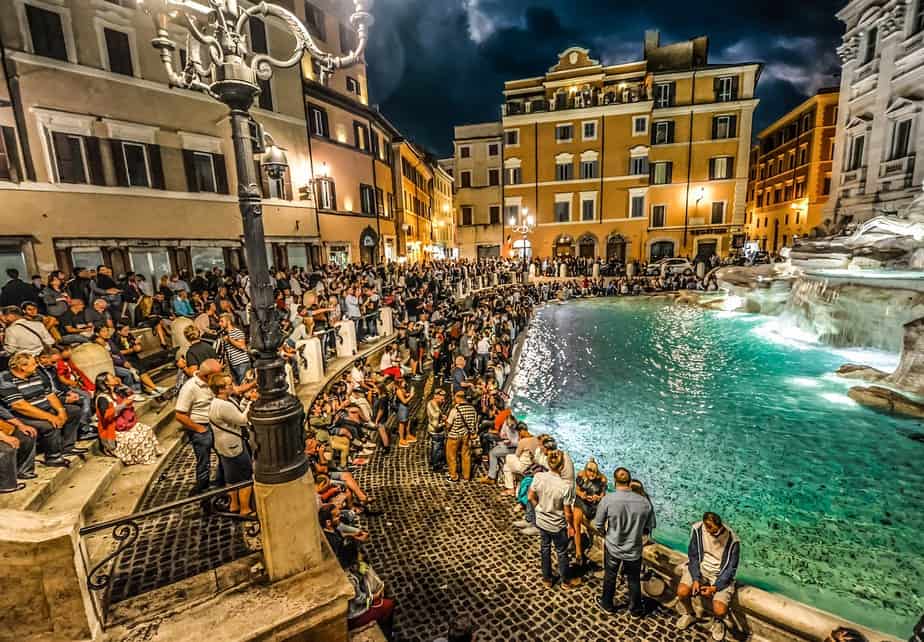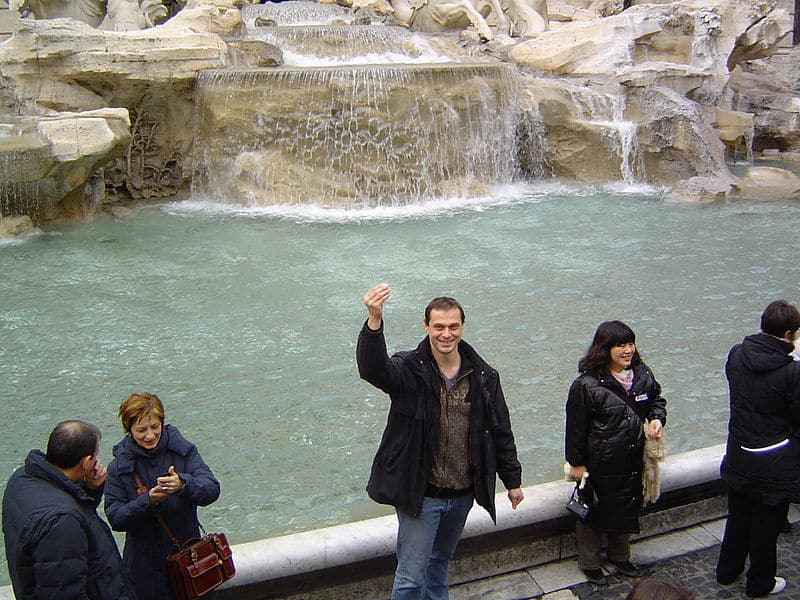A Visit to the Trevi Fountain
The Trevi Fountain is the largest baroque fountain in Rome and one of the most beautiful fountains in the world. A visit to the Trevi Fountain is a unique experience that no one passing by the city should miss.
However, heading to the fountain without proper planning might make your experience unforgettable for the very wrong reasons. The Trevi Fountain is one of the trickiest places in Rome. It is located within narrow streets and is always crowded.
While running away from the crowds is a bonus in most of Roman sites, at the Trevi Fountain it is actually indispensable, especially if you are on a wheelchair. So to make sure you don’t miss a thing, here are my recommendations for a visit to the Trevi Fountain!
The story of the Trevi Fountain
Although the Trevi Fountain as we know it started to be planned in the 18th century, its story goes way back in time.
In 19 B.C., a virgin young woman led thirsty Roman soldiers to a source of water around 8 miles away from the city. The source was later added to the system of aqueducts that supplied Rome, and the new aqueduct was called Acqua Virgo.
At that time, a fountain was placed at the end of the aqueduct, the Trevi Fountain, which was located in the meeting point of three streets. Some believe that is the origin of its name: “tres viae” in Latin, “tres vie” in Italian, meaning “three streets” or “three ways”. In Ancient Rome, that region was called Trebium, which is also a possible origin of the fountain’s name.
After the fall of the Roman Empire, the aqueduct was neglected for many centuries. Despite being repaired by Pope Adrian I in the 8th century, the major restoration of the Acqua Virgo took place nearly a millennium later, in the 15th century, when Pope Nicholas V completely remodeled the aqueduct and renamed it Acqua Vergine.
In 1629, Pope Urban VIII had Italian sculptor and architect Gian Lorenzo Bernini sketch a new design for the Trevi Fountain. When the pope died, the project was abandoned. A century later, in 1730, Pope Clemens XII held a contest to select a new design for the fountain. Nicola Salvi was awarded the project, but died before the end of the construction. The project was then handed to architect Giuseppe Panini, and was completed in 1762.
How to get there
Now that you know the Trevi Fountain’s story, it’s time to get there!
The Trevi Fountain is located at Piazza di Trevi, at Via delle Muratte. Since the streets that lead to the fountain are very narrow, no buses or unauthorized cars go through them. That means that, independently of your means of transport, you will have to walk few meters to get there.
IF YOU ARE HEADING TO THE TREVI FOUNTAIN BY METRO, THE NEAREST STOP IS AT BARBERINI STATION, LINE A (RED LINE).
BUS LINES THAT STOP NEAR THE TREVI FOUNTAIN ARE 160, 492, 62, 63, 80, AND 83.
IF YOU PREFER TO TAKE A TAXI, YOU CAN CALL ONE ON THE NUMBERS +39 060609 AND +39 06 3570. YOU CAN ALSO SEND AN SMS TO +39 366 673 0000, WRITING JUST YOUR CURRENT ADDRESS ON THE SMS TEXT. TAXIS IN ROME ARE WHITE.
The Trevi Fountain is just a 10-minute walk away from the Spanish Steps, which is right next to the Spagna metro station, at Line A (red line).
Many hop-on hop-off sightseeing buses have stops nearby the fountain.
No tickets are necessary
Visiting the Trevi Fountain doesn’t cost you anything and you don’t need to present any sort of entry ticket. The fountain lies on a public street and anyone can visit at any time.
But if you want to improve your visit and learn more about the fountain as you see it, many travel agencies offer guided tour packages that include the Trevi Fountain. You can also carry a guide book or e-book with you.
The best time to visit
During the day
Visiting the Trevi Fountain is not an easy task. Put the fountain’s popularity and the narrow streets that lead to it together and you will be able to imagine why. It’s insanely crowded – and when I say insanely, I mean it.
From 10 am to around 6 pm, it’s very hard to even walk without having to squeeze yourself among people from time to time.
IF YOU WANT TO WITNESS THE TREVI FOUNTAIN’S SPLENDOR DURING THE DAY, THE BEST TIME TO VISIT IS BETWEEN 7 AM AND 10 AM.
This is when the amount of people around the fountain is still moderate. But if you’ve been daydreaming about that magnificent photo with the entire Trevi Fountain behind you, make sure you show up at the same time as the sun. No joke!
In summer, some people arrive as early as 6 am to have a chance to take a photo alone in the fountain without any part of it out of frame.
At night
During a major restoration sponsored by the Italian fashion company Fendi, which happened between June 2014 and November 2015, more than 100 LED lights were added to the Trevi Fountain. The light system is really incredible and a nighttime visit is definitely worth it.
THE BEST TIME FOR A NIGHTTIME VISIT TO THE TREVI FOUNTAIN IS AFTER 9 PM.
Visiting on a wheelchair
If you are visiting the Trevi Fountain on a wheelchair, make sure you schedule your visit within the recommended hours!
The streets surrounding the Trevi Fountain are cobblestone streets, so going around might already be a little difficult. With the crowds, approaching the fountain will be nearly impossible.
The biggest challenge onsite, however, is the set of stairs between the street and the fountain itself. There is never an empty spot on the stairs. People usually just stand there as their inclination makes it a little bit easier to see through the crowd. But if you are on a wheelchair, you won’t be able to get close enough to the fountain and the crowd will really block your view.
So, again, stick to the recommended hours!
Make a wish
No visit to the Trevi Fountain is complete without throwing a coin into the water – or two, or three.
Throwing coins into fountains dates back to Ancient Rome, when travelers used to throw coins as offers to the gods of water hoping to have a safe journey. Carrying on with the tradition in the Trevi Fountain became particularly popular after the movie Three Coins in the Fountain, released in 1954.
Legend says that a coin thrown at the Trevi Fountain will ensure your return to Rome; two coins will make you fall in love; and three coins will make you get married.
The coins are collected every night by Rome’s authorities and are used to subsidize grocery items for poor families. Around 3,000 euros are collected from the fountain every day!
So don’t forget: before you leave, throw a coin!
Planning a trip to Paris ? Get ready !
These are Amazon’s best-selling travel products that you may need for coming to Paris.
Bookstore
- The best travel book : Rick Steves – Paris 2023 – Learn more here
- Fodor’s Paris 2024 – Learn more here
Travel Gear
- Venture Pal Lightweight Backpack – Learn more here
- Samsonite Winfield 2 28″ Luggage – Learn more here
- Swig Savvy’s Stainless Steel Insulated Water Bottle – Learn more here
Check Amazon’s best-seller list for the most popular travel accessories. We sometimes read this list just to find out what new travel products people are buying.





